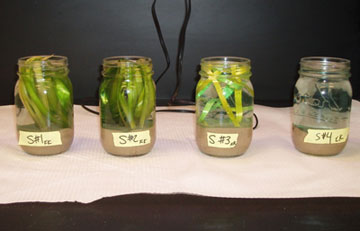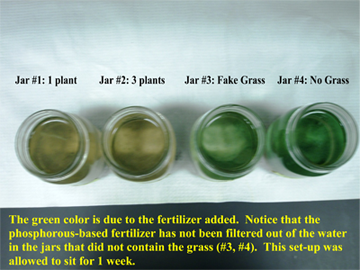Students add nutrients to and observe 3 different jars filled with pond water and various amounts of underwater grass, looking for algal growth over 3-5 days. Phosphorous will be added to the water to stimulate the growth of the algae.
Objectives
Students will gain a better understand of the following ecological services provided by underwater grasses: Underwater grasses help remove excess nutrients from the water.
Materials
- Seagrass or other aquatic plant, such as jungle vallisneria (Vallisneria Americana). It can be ordered online from That Pet Place and shipped via FedEx. Please see the Lesson Resources section for ordering information.
- Small sized gravel/sand
- 3-4 large jars or beakers per group
- Window or Light source with timer
- Phosphorous-rich Fertilizer (Schultz’s Bloom Plus Plant Food with an N-P-K ratio of 10-54-10 works well and is available at stores like Ace Hardware and Lowes.)
- Pond water
- Optional:
- Digital camera to record transformation throughout the week
- Artificial aquarium plant (or pieces of smooth curling ribbon)
- Microscope, slides, cover slips, and eyedropper to look for algae growth
Procedure
 A couple days before the beginning of the unit, make sure the students are familiar with the steps involved in setting up and carrying out a controlled experiment. Present the students with the Student Worksheet (download from the Lesson Resources section, below) and show them the supplies available. Their job is to design an experiment to test the idea that underwater grasses remove excess nutrients from the water. An example of one possible setup to determine if the amount of grass is related to the amount of nutrients used is: Jar #1 sand, pond water, three seagrass plants; Jar #2 sand, pond water, one seagrass plant; Jar #3 sand, pond water, fake grass plant; Jar 4 sand, pond water, no grass plant. If there are limited supplies and each group of students is not able conduct their own experiment, have the class discuss different possibilities and then settle on a class procedure. (This engagement activity needs to be set up first, but will be analyzed by the students last.)
A couple days before the beginning of the unit, make sure the students are familiar with the steps involved in setting up and carrying out a controlled experiment. Present the students with the Student Worksheet (download from the Lesson Resources section, below) and show them the supplies available. Their job is to design an experiment to test the idea that underwater grasses remove excess nutrients from the water. An example of one possible setup to determine if the amount of grass is related to the amount of nutrients used is: Jar #1 sand, pond water, three seagrass plants; Jar #2 sand, pond water, one seagrass plant; Jar #3 sand, pond water, fake grass plant; Jar 4 sand, pond water, no grass plant. If there are limited supplies and each group of students is not able conduct their own experiment, have the class discuss different possibilities and then settle on a class procedure. (This engagement activity needs to be set up first, but will be analyzed by the students last.)- Add fertilizer to all of the jars on day 1. Use about 1 g of fertilizer for every 100ml of pond water used. A fertilizer with a high amount of phosphorous should be used in order to stimulate the growth of freshwater algae. (In sea w
 ater, nitrogen is the limiting nutrient for algae growth, so you could also do this experiment with saltwater and a different grass species but you would need to use a fertilizer with a higher ratio of nitrogen to phosphorous instead).
ater, nitrogen is the limiting nutrient for algae growth, so you could also do this experiment with saltwater and a different grass species but you would need to use a fertilizer with a higher ratio of nitrogen to phosphorous instead). - The jars should be placed by a sunny window or grow light on a timer if no window is available.
- Have the students make visual observations about the cloudiness of the water, the color, etc. The students may also take a couple drops of water out of the jars and observe them under the microscope. Algal growth or removal of fertilizer should be observed by day 5-7. The difference between the jars with the grass and the jars without the grass should be obvious to the naked eye, but a microscope could also be used on the final day to record other observations and check for signs of algal growth. Please see the image entitled “Activity 1 Results” in the Lesson Resources section for an example of what the water in the jars might look like after a week. Notice that the green-colored fertilizer has decreased more in the jars that contained the grass.
- At the end of the observation period, students will make final observations. The jars with the grass should have minimal algae and the clearest water. Jars with artificial grass or no grass should have the most algal growth and the fertilizer should still be present. Since the underwater grass uses the available phosphorous in the water, it prevents the algae from growing unrestrained.
- After the students have completed several of the engagement activities, show the brief intro video from the COSEE website to help the students understand a little bit more about seagrasses before proceeding.
References
- That Pet Place Website for ordering grass: http://www.thatpetplace.com/pet/cat/info/23204/category.web “Jungle Vallisneria” or Vallisneria americana, Item #YH:208853
National Science Education Standards
9-12 A. Science as Inquiry Abilities
9-12 C. Life Science
- Interdependence of organisms
9-12 C. Science in Personal and Social Perspectives
- Personal and community health
- Environmental quality